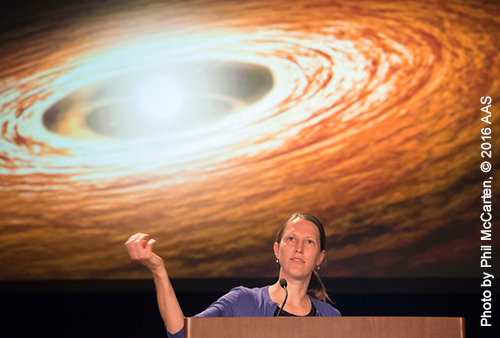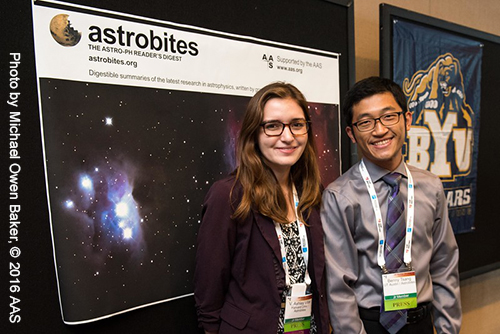How Can AAS Meetings Be Improved? Part 1
Stephen Unwin JPL
This is the first of two articles about the future of AAS meetings. Part 1 discusses the big-picture view: What purpose do our meetings serve, and are we addressing the needs of the membership, and do we respond to feedback? Part 2 will cover some of the practical details of making changes: considerations of cost, meeting locations, scientific content, and logistics.
It has been many years since the AAS Council has considered a systematic review of how the Society runs its meetings. I chaired the AAS Meetings Task Force during the past year to tackle this question. We realized immediately that this is not a simple question — opinions differ widely on what constitutes a successful meeting, and suggestions for improvements span a wide range. We made sure the task force represented a spread of career stage and types of institutions — including large universities, small colleges, industry, faculty, and graduate students:
- Dara Norman, NOAO
- Jason Wright, Penn State
- Lee Anne Willson, Iowa State
- David Hogg, NYU
- James Lowenthal, Smith College
- Nancy Brickhouse, CfA
- Jean McKeever, New Mexico State
- Bill Purcell, Ball Aerospace
- Joel Parriott, AAS (ex officio)
- Steve Unwin, JPL (chair)
A goal of our study was to take as broad a view as possible, by considering the interests and preferences of attendees and the pros and cons of many possible changes that could be made. Early on, we recognized that even with a diverse team, we needed a much broader sample of AAS members’ input on meetings, so we conducted an online survey, polling approximately half the membership with a long series of questions and space for write-in comments. The AAS Meetings Task Force Report details our findings and recommendations, along with a summary of the survey results (data that might be individually identifiable, including a voluminous set of write-in comments, were redacted). The survey was not analyzed statistically, due to the complex and often strong interactions between the questions. Instead, we used this database (from more than 500 responses) as a resource for ensuring that our recommendations were not "out of line" with members’ opinions.
Starting at the very beginning, we asked: Why do we hold in-person meetings? Astronomy has always been an evolving field, but the pace of change in increasing, driven in large part by vastly more capable instrumentation, big data, and powerful software tools to analyze these data. These changes affect the way astronomers work, how they publish, and how they communicate. AAS meetings are fundamentally about communication, so our task force had to understand what it means to hold face-to-face meetings in an era in which communicating with colleagues, whether individually or in groups, has never been easier. Our survey results indicate that there is a strong desire for the AAS to continue to facilitate through its meetings the interactions that a highly collaborative field like astronomy needs to thrive.
 The central feature of AAS meetings is the opportunity for every member attending to present their work, a tradition that will be continued. A gathering of a large number of astronomers, such as our annual winter meeting, exposes members to many different disciplines, with the opportunity to learn outside of their own specialty, to reunite with geographically distributed colleagues, and to make new contacts and collaborations. For those exploring grad school choices and those looking for jobs, many colleges and employers attend to make contact with prospective students and hires.
The central feature of AAS meetings is the opportunity for every member attending to present their work, a tradition that will be continued. A gathering of a large number of astronomers, such as our annual winter meeting, exposes members to many different disciplines, with the opportunity to learn outside of their own specialty, to reunite with geographically distributed colleagues, and to make new contacts and collaborations. For those exploring grad school choices and those looking for jobs, many colleges and employers attend to make contact with prospective students and hires.
These are attributes of the winter meeting that we want to keep and to improve. But we must also understand and adapt to changing expectations from members, especially younger astronomers who use social media as tools in their research. Meeting content has to evolve to reflect demand, with examples like sessions on diversity and inclusion, workshops and tutorial sessions on new analysis packages and tools, and the wildly popular collaborative hack days.
 Meeting cost is a major concern for most attendees, and increasingly so for those who have to make hard budget choices between attending AAS meetings, observing, publishing, and supporting their own and their students’ research. Keeping a lid on costs is a continual concern for the AAS meeting staff. Wisely, the AAS has a small staff of full-time experts who negotiate contracts with hotels and meeting venues and handle the logistical tasks of processing registrations and abstracts and all the myriad details that must be dealt with so that the meetings can run efficiently. It’s a truism (familiar to anyone who has organized a conference or workshop) that the planning and organization (and sometimes also the organizers) are invisible — but only if the meeting goes smoothly!
Meeting cost is a major concern for most attendees, and increasingly so for those who have to make hard budget choices between attending AAS meetings, observing, publishing, and supporting their own and their students’ research. Keeping a lid on costs is a continual concern for the AAS meeting staff. Wisely, the AAS has a small staff of full-time experts who negotiate contracts with hotels and meeting venues and handle the logistical tasks of processing registrations and abstracts and all the myriad details that must be dealt with so that the meetings can run efficiently. It’s a truism (familiar to anyone who has organized a conference or workshop) that the planning and organization (and sometimes also the organizers) are invisible — but only if the meeting goes smoothly!
Unfortunately, the options for reducing meeting cost, especially for the large winter meetings, are limited, and the task force weighed the merits of a number of changes that would have far-reaching implications. For instance, one way to reduce costs is to hold meetings in smaller cities that may have more affordable hotels; but for the winter meetings, there aren’t a lot of affordable choices among venues that can comfortably accommodate us. In addition, travel to smaller cities may be more expensive, and if attendance drops, the costs must be amortized across fewer attendees.
These are some of the big-picture issues that the task force grappled with. The report is very detailed — a reflection of the complexity of the issues and the long list of changes that the AAS could consider making. In Part 2, I’ll go into some of the specific questions that we tackled — like the role of the summer meeting compared to the winter meeting — and how we should evolve the technical content of our meetings.
On behalf of the Council I’d like to thank the members of the Meetings Task Force for their work on the study, through a long series of telecons and emails, exploring every angle of the problem. I also thank the AAS Executive Office staff for their support in providing meeting attendance and meeting cost data and for distributing the member survey last summer.
Steve Unwin
AAS Council
Meetings Task Force chair

